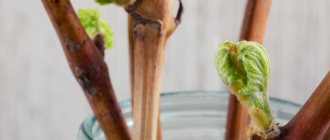The rose has long occupied a leading position among garden plants. Compact, low varieties and varieties of garden beauties began to be cultivated at home, and they were called “indoor (house) roses.” Initially these were hybrids of tea roses, miniature roses and some low-growing species. Nowadays, a large number of varieties and species have been bred specifically for indoor cultivation. To propagate your favorite variety using one of the proposed methods, you need to take into account the characteristics of the plant and its capabilities.
Preparing cuttings for propagation
How to root a rose? A strong shoot is selected from the plant, which is ready to flower, or a faded, semi-lignified stem. It is not recommended to use thin, weak stems with dead leaves for cuttings. If the thorns on the shoot break off easily, it means it is ready for cuttings.
The stems should be cut with a sterile, sharp instrument. The cuttings for propagation should be from 12 to 15 cm long and have two or three buds and at least two or three leaves. There should be no buds or flowers on it. After the cuttings are cut, they need to be processed. To do this you should:
- Remove lower thorns and leaves.
- Shorten the remaining leaves by two-thirds of the length. This is necessary so that during rooting the moisture does not evaporate too quickly.
- Keep the pieces in a solution of Kornevin or Heterouxin, which are diluted according to the instructions.
How to propagate: step-by-step instructions for planting and growing at home
Inventory and materials
To cut an indoor rose, you need to prepare a knife or pruning shears. They must be sharp so that notches do not remain on the stem, as a possible source of infection. For the same purpose, it is advisable to disinfect the entire instrument with alcohol or potassium permanganate before use.
Priming
To root the cuttings, you can use light and nutritious soil for roses purchased at a specialized store, or you can simply mix sand and peat (or sand and vermiculite) in equal proportions. As an option: humus, peat and sand in proportions 2:2:1. Or 2 parts turf, 1 part leaf soil, 1 part sand.
Pot
After rooting in water, the cuttings are planted in a 200 ml container; a container of the same volume is suitable for rooting cuttings in the ground. For these purposes, it is better to use a transparent container: this will make it easier to observe the development of the roots. If there are a lot of cuttings, then rooting is done in special boxes or transparent plastic containers.
After the root system has grown, the young seedling is transplanted into a 500 ml pot, and then into a container with an even larger volume. The main condition for a container of any volume is the presence of holes at the bottom to drain excess water.
Attention! It is not recommended to plant a rose in an overly large pot, as there is a danger of uneven moisture, stagnation of moisture, and the appearance of pests that spoil the roots.
Rooting material
Propagation material - cuttings are obtained by pruning indoor roses. There is an opinion among flower growers that a shoot suitable for cuttings must have a bud. But it is better to take cuttings from a healthy and strong stem that has just faded.
A cutting from the middle part of a branch without any damage, about 12 cm long, should have more than two buds from which shoots will grow. The optimal thickness of this cutting is 2.5 – 3.5 mm. The cuttings are cut from below along an oblique line, and from above - in a straight line. The cut should be made under the bud from below and above the bud at a distance of up to 1 cm from above.
Treatment
The existing lower leaves on the cuttings should be removed, and the remaining ones should be cut in half so that during rooting the moisture does not evaporate too quickly. Before rooting the cutting in the ground, you should dip its tip into water, and then into a root formation stimulator, for example, “Kornevin” or heteroauxin. If you use "Epin", then make a solution from it according to the instructions (100 g of the drug per 1 liter of water), in which the sections are kept for 8 - 12 hours.
How to root correctly?
In water
Rooting in water is recommended to be done in a small glass or plastic container, preferably dark glass or plastic.
The water level (it is better to use boiled or melted water at room temperature) in the container should be such that the lower part of the cuttings is in the water, and the rest is above the water. This condition is explained by the fact that oxygen is needed for roots to appear. As a rule, the root system is formed on the cutting just at the border of water and air in the container.
Important! Roots do not form on cuttings immersed in raw water!
Some gardeners do not recommend immersing the shoot in water so that its tip touches the bottom of the dish: this can cause it to rot. It is also not recommended to change the water in the vessel, but only add it as it evaporates. Also, some florists practice adding activated carbon tablets to the liquid to disinfect it, and the drug “Kornevin” is often added.
The vessel with the cuttings is placed in a warm and bright place, but not in direct sunlight. You can cover everything with a plastic bag to create greenhouse conditions. After the appearance of roots 0.7 - 1.5 cm long (about 3 weeks), the plant can be planted in the ground.
Some gardeners act differently: the cuttings are kept in water until callus appears, after which they are immediately transplanted into the ground. In their opinion, if you wait for roots in the usual sense, then such a cutting will find it difficult to adapt to new conditions and may simply die.
In the ground
The rose also takes root in the ground. The shoot should be buried obliquely into moist soil by 1 - 1.5 cm and the soil should be compacted around the cutting. Rooting is more likely to succeed if the top of the pot is covered with a jar or plastic bag.
With the appearance of the first roots and leaves, after about 5 weeks, you can introduce air into the “greenhouse” (this must be done gradually so that the plant gets used to the drier air of the room), and then remove it completely.
The optimal conditions for the development of shoots are considered to be a temperature of +20C - +25C, moderate watering, diffused sunlight (daylight duration is at least 15 hours), regular spraying (maintaining humidity at 80% - 90%).
If rooting was carried out in a common container, then over time the seedlings should be planted one at a time, keeping a distance of 5 cm between them.
When to plant?
If the cutting was rooted in water, then a pot with a diameter of 10 - 12 cm should be filled halfway with soil, and then holding the plant at the desired height with one hand, add soil with the other. Then you should press the soil around the seedling, water it abundantly, if necessary, add more soil. There is no need to install a greenhouse, since the root system of the cuttings has already developed.
When rooting in the ground, when the cuttings develop a root system and the pot becomes small (roots will become visible in the drainage holes), they should be transplanted into deeper containers (volume 500 ml), while fertilizing them with humus.
Planting should be done using the transfer method: the rooted cuttings are carefully removed from the old pot and, without shaking off the earthen lump, placed in a new container, the resulting voids in which are filled with soil. We should not forget that the bottom layer in the pot must be drainage.
The young rose should not be touched until next spring. In August - September, flowers may already appear on the seedling, but you should not allow them to bloom so that the plant does not become depleted and overwinters normally.
How to root a cutting from a bouquet?
To propagate roses from a bouquet by cuttings, it is recommended to use flowers of local origin. Because flowers arriving from Holland and other countries are treated with special preservatives before shipping and are not capable of producing roots.
When choosing a rose from a bouquet for propagation, you need to pay attention to the following points:
- The stem should be lignified.
- Roses should be rooted from a fresh bouquet, not dried ones. If you like the variety and want to grow one at home or in the garden, then the flowers should be used immediately.
- A cutting of medium thickness should have buds in the lower and upper parts.
Before rooting and propagating a rose, buds, flowers and thorns are removed from the bouquet. The cutting should be 15-30 cm long. Before placing it in water, the leaves from the bottom of the stem are torn off and the remaining ones are cut off by 2/3. Containers with cuttings are placed in a lighted place where there is no direct sunlight.
You will be interested to know: 6 main rules for caring for an indoor rose after purchasing it in a store
A rose cutting from a bouquet should be kept in water until roots appear on it. After this, it can be planted in a container with soil and covered with a jar for better rooting.
Attention! When cutting a rose, the cut should be made obliquely. It should be located 1.5-2 cm above the top node and immediately below the bottom node.
Burrito method
There is no 100% guarantee that roots will appear when using this method. But the Burrito method is so simple that you can still try it.
How to propagate indoor roses at home? Try following the following instructions:
- Cut the selected shoots of the bush into cuttings. Moisten the lower parts of the cuttings with “Kornevine” or a similar preparation.
- Take newspaper, wet it well, and wrap the bottom of the cuttings.
- Next, the package needs to be put away in a warm but dark place.
According to reviews from people who have already tried this method, roots can appear within two weeks. Be sure to keep the newspaper bundle moist, otherwise the cutting will simply dry out.
Rooting indoor roses in water
For this method of propagation at home, dwarf and miniature roses are best suited. Annual shoots that have produced buds are rooted in water. You can cut them before or after flowering.
It is recommended to propagate indoor roses using cuttings in spring and summer, when daylight hours are long. The cuttings are cut and processed in the manner described above and placed in a container of water. It is best to choose opaque containers or dark glass vessels in which the water will not bloom.
Water is used at room temperature, separated. During the rooting process, water will evaporate, so it needs to be added, but not changed.
Air layering
Propagation by layering is used for varieties whose cuttings are difficult to root or do not produce roots. Varieties of climbing and ground cover roses are excellent for this method. Its disadvantage is that not every indoor rose grown using layering blooms. They begin propagation by layering in early spring.
To obtain them, all leaves are removed from the bottom of the shoot, the bark is cut, making several longitudinal cuts (8-10 mm) with a sharp knife. You can remove almost all the bark in a circle on an area 8-10 mm long, leaving only 1/3 of the area. A bag of wet sand (soil) is tied under the cut so that the area without bark is covered. The package is tied and secured to a branch with twine or tied to a peg stuck nearby.
If the bush is large, then instead of a bag, take a plastic cup, cut it on the side, cutting out a hole for the branch, fasten the cut walls with tape and tie it, also with tape, to a peg installed near the branch. Pour soil into a glass and water it. After 2.5-3 months, roots will form at the cut site. The branch is cut and planted in a pot with prepared soil. If the procedure fails, the stem is cut above the cut and rooted in any way.
Indoor roses propagated at home are already adapted to the environment, which gives them a bonus for successful development and simplifies their care. In order not to make a mistake in choosing a propagation method, you need to carefully familiarize yourself with the characteristics of the variety, the requirements for growing and maintenance conditions.
Roses in potatoes
You can propagate roses in this way at home or in open ground. When taking cuttings at home you should:
- Make a hole in the potato tuber along the diameter of the stem.
- Fill a pot or other container with a nutrient mixture.
- Place the tuber in moist soil and stick the cutting into it.
- To create a greenhouse effect, cover a piece of rose with a transparent bag or plastic bottle.
- Before the roots appear, place the container in a warm, well-lit place, away from direct, burning rays of the sun.
If roses are going to take root in the garden, in open ground, then a trench is first prepared for this, the depth of which should be fifteen centimeters. The bottom of the trench is covered with a five centimeter layer of sand.
To root rose cuttings in potatoes, they must be inserted into a tuber from which the eyes have first been removed. Then the potato along with the cutting is placed in a trench and dug in two-thirds of the way. The distance between roses in potatoes should be at least fifteen centimeters.
The pieces are covered with a transparent glass container or bag for about two weeks. After this, they need to be gradually accustomed to the open air, for which the can is removed from them every day for a while. As a result, a month after planting, the shelter will need to be removed completely.
You will be interested to know: When and how to properly replant indoor violets so that they grow and bloom well
What is the secret to propagating roses in potatoes? From potatoes, cuttings obtain carbohydrates and starch that are beneficial for them. In addition, potato tubers have a constantly moist environment, which is necessary for the formation of roots.
Caring for potato cuttings involves regular watering of the soil. Every five days it is recommended to water the soil with sweet water (two teaspoons of sugar for one glass of water).
Possible problems and difficulties
Inexperienced gardeners often make mistakes when propagating roses. They may not have the best effect on the health of the plant. One of these mistakes is incorrect watering mode . As a result:
- powdery mildew;
- rust;
- black spot.
Their treatment consists of treating the bushes with effective mixtures and pruning the affected branches.
Most often, a rose is affected by spider mites . As a preventative measure, the premises in which indoor roses grow should be treated once every six months. A sign of infection is the curling of rose leaves.
Treatment consists of treating the leaves with a special solution on both sides in the open air. The rose has beautiful and unusual flowering. In order for it to please the eye for as long as possible, you just need to create favorable growing conditions for it and ensure proper reproduction. Which is not that difficult.
Other methods of propagating roses from cuttings
Propagation of roses by cuttings in a bag
For roots to appear within three to four weeks, you can use store-bought moss. The rose cuttings are wrapped with damp moss from below, then placed in a bag or wrapped in cellophane. The bag will need to be inflated and tied. With this method of propagation, the cuttings, along with moss and a bag or cellophane, will need to be hung in a well-lit place, for example, above a windowsill.
For better rooting, you can use a solution of water and aloe juice (9:1), which moistens the moss. Instead of moss, roses can be placed first in sterile soil and then in a bag.
Trannoy method
With this method of propagating roses at home, even before cutting, the shoot should be prepared:
- During flowering (June-July), two leaves and the top with a withered bud are cut off from the selected stems.
- You need to watch the shoots so as not to miss the moment when the buds below swell.
- As soon as the buds swell, the stem needs to be cut into cuttings. You need to have time to carry out this procedure before the leaves appear from the buds.
- The lower leaves are removed from cuttings 20 cm long.
- Each segment should have two leaves at the top.
- Such cuttings are planted immediately in a permanent pot or flowerbed.
- Several pieces are stuck into one hole or pot at an angle of 45 degrees. One or even several will definitely take root.
- The planting material is covered from above with a plastic container, from which the narrow part is cut off.
Caring for rose cuttings involves watering the soil and loosening it so that the emerging roots have access to oxygen.
Burrito Method
This method of propagating roses does not give one hundred percent rooting, but it is quite easy, so you can try it. To implement this, cuttings are cut, the lower end of which is treated with Epin or Kornevin. After this, the chopped stems are wrapped in damp newspaper. They should be placed in a dark place with an air temperature of +15 to +18 degrees. In about two weeks, roots should appear, but there is no guarantee. It is necessary to ensure that the newspaper remains moist.
You will be interested to know: Growing lilies at home in pots: planting and care step by step with photos
How to propagate a rose in the ground?
For rooting in the soil, cuttings prepared and treated with Epin or Kornevin are placed 1/3 in a nutrient mixture and covered with a bag or jar. The shoots should be placed at an angle of 45 degrees. It is imperative to ensure that the lower bud is buried in the ground. Before use, the soil is spilled with a steep solution of potassium permanganate.
Care all year round
In the spring, prune, this promotes the development of side shoots, the bush will become more luxuriant. Root and plant the cut cuttings. You need to trim old shoots, dried ones, as well as young and strong ones! Usually the shoots are pruned so that those remaining on the bush have at least three buds.
When it gets warm outside, put the rose on the balcony, this has a beneficial effect on its health. You don’t have to clean it up at night; we have already said that the plant easily tolerates temperature changes.
The first buds should be removed so that the rose blooms more abundantly. Next, do not forget to remove flowers that have faded.
Stop fertilizing in the fall; watering will also need to be reduced. Humidify the indoor air during the heating season, as dryness leads to the appearance of spider mites on the bushes.
We told you how to propagate roses from cuttings at home and the rules for caring for them. We hope this information will help you grow a beautiful and healthy plant!
Care after landing
Planting future bushes in open ground is carried out after acceleration. Roses need regular soil moisture. This does not mean that you need to water abundantly.
A common mistake for newbies. With heavy watering, the roots begin to rot. In this case, it is necessary to approach the moisturizing procedure without fanaticism. You can add sand, sawdust, perlite and vermiculite to the soil. This will create looseness for oxygenation. You can add used tea leaves. Fertilizers are also important. Roses prefer mineral preparations.
- Phosphorus improves flowering.
- Magnesium stimulates the production of chlorophyll.
- Potassium regulates moisture in cells and enhances resistance to diseases.
- Nitrogen improves the development of shoots and leaves.
- Calcium promotes faster development of the root system.
But you should carefully consider the choice of fertilizers. For example, beginners often make the mistake of choosing fresh bird droppings and cow manure. This destroys the seedlings. To use these components correctly, you need to combine 1 liter of litter or manure with 10 liters of water.
Problems and difficulties during cuttings, solutions:
- Plants don't like chlorine. Tap water is not suitable for irrigation as it destroys nutrients. The cuttings may die. Before use, it is recommended to soften the water: boil or infuse for 2-3 days. It is best to use rain or snow water.
- Root rot occurs due to overwatering. In order to stop the decay process, watering should be reduced.
- Slow acceleration is one of the main obstacles to rooting pink cuttings. The plant does not like crowded conditions. The farther apart the cuttings are located, the better they take root. You can also influence acceleration by using peat tablets. This is an environmentally friendly drug without additives, available in any specialty store. The same can be said about coconut tablets.
- The development of cuttings may be reduced due to a lack of ultraviolet radiation. To create the necessary lighting, you need to install a greenhouse in a bright room or use special phytolamps.
- Poor development or death of the cutting may depend on the mother plant. It is not recommended to use a rose grown from a cutting for cuttings.











